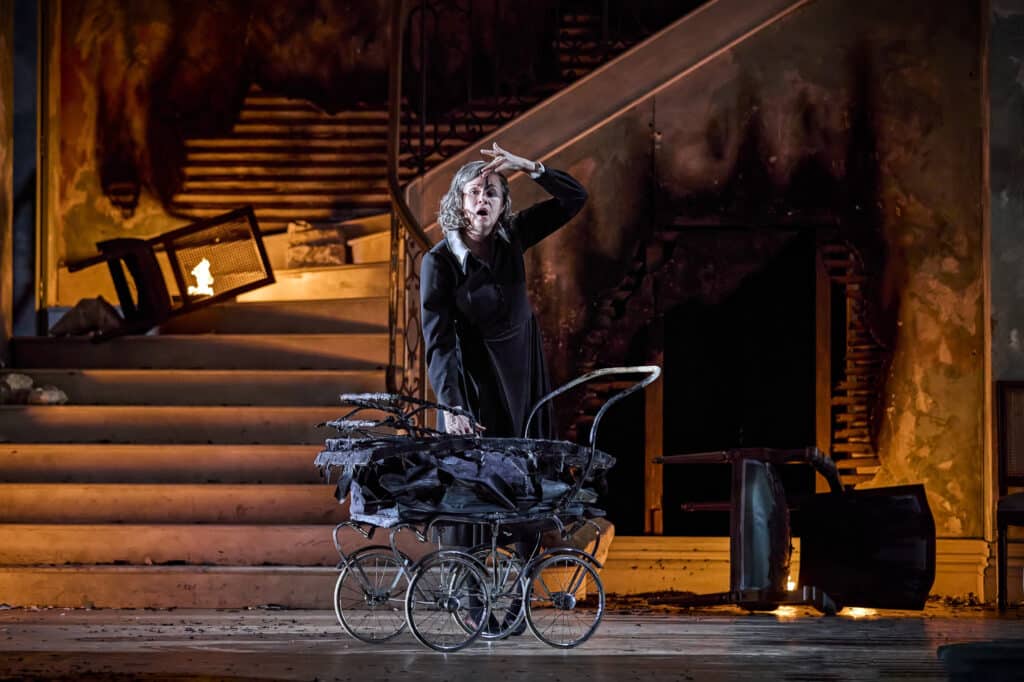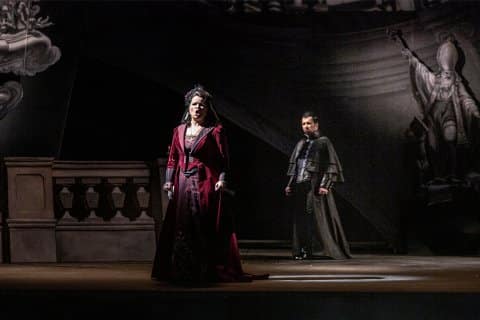TRUBADUREN • HAMBORG
★★★★☆☆

Photo: Brinkhoff-Moegenburg
REVIEW IL TROVATORE: BONFIRE, FIRE AND BUUH’S IN HAMBURG
Chinese soprano Guanqun Yu impresses with beautiful, lyrical coloratura in the central role of Leonora in Verdi’s haunting The Troubadour, which, despite strong soloists, colorful orchestral playing and ambitious set design, received a mixed reception from discerning German opera audiences at its premiere at the Hamburgische Staatsoper.
The action has moved from the Middle Ages to the period before the Spanish Civil War in the 1930s, where the Count’s tuxedo-clad entourage is gathered for drinks in an old palace where the plaster is crumbling from the walls. Decay is underway.
Turkish/German director Immo Karama, with more than 50 productions at major theaters and opera houses to his credit, wanted to portray Count Luna’s court as a bunch of brutal, fascist chauvinists, so he added a scene where they rape one of the maids on a sideboard in the middle of the stage.
This was NOT popular with the audience here in Hamburg, which has more millionaires among its inhabitants than any other German city – and which clearly doesn’t put up with harassments.
The boos rained down on the actors, who didn’t know what to do and could do nothing but play on with their eyes darting and the orchestra running at full blast.
As in a football stadium, where it is not uncommon to boo opponents who have made an unfortunate impression with, for example, brutal play, a completely unfair persecution of some of the male leads began.
First and foremost, the well-singing Count Luna in Russian Aleksei Isaev’s rich character and dominant baritone was affected.
Also affected was tenor Gwyn Hughes Jones, who did a good job as Manrico and was unfairly booed after the signature aria Di Quella Pira, and subsequently performed with something resembling a serious blow to his confidence.
Verdi has equipped The Troubadour with a series of insanely beautiful choral pieces, which are delivered at full power by the large opera chorus in beautiful mass choreographies, momentarily frozen in cinematic stills.
The affinity with the choral pieces in La Traviata and Rigoletto, which Verdi composed with the Troubadour within two years, is clearly noticeable.
Quite a triple and a creative highlight in the Italian maestro’s career.
This Hamburg staging features a particularly striking stage design, best remembered for large projections of flames and ghostly silhouettes on the walls of the battered palace.
A baby carriage, from the interior of which flames rise in a terrifying sight, is an iconic visual apex that frames the play’s real protagonist, the gypsy daughter Azucena, whose mother was burned at the stake because she was unjustly accused of causing the feverish death of one of the count’s sons.
Russian mezzo Elena Maximova is strong in the traumatic role of the avenger who triumphs in the horror opera’s vicious finale.
A slightly messy twang ending where the macho Count Luna executes the troubadour/rebel Manrico with what looks like a sawed-off shotgun, unaware that the two men, who are both courting Leonora’s love, are in fact brothers.
There are four stars from GOT TO SEE THIS to The Troubadour, which is skillful opera craftsmanship of high, but at times slightly uneven quality.


![★★★★★☆ REVIEW IL TROVATORE: DEVILISHLY GOOD VERDI IN ZURICH iltrovatore_c_monikarittershaus_132[1]](https://detskuduse.dk/wp-content/uploads/2022/10/iltrovatore_c_monikarittershaus_1321-480x270.jpg)

